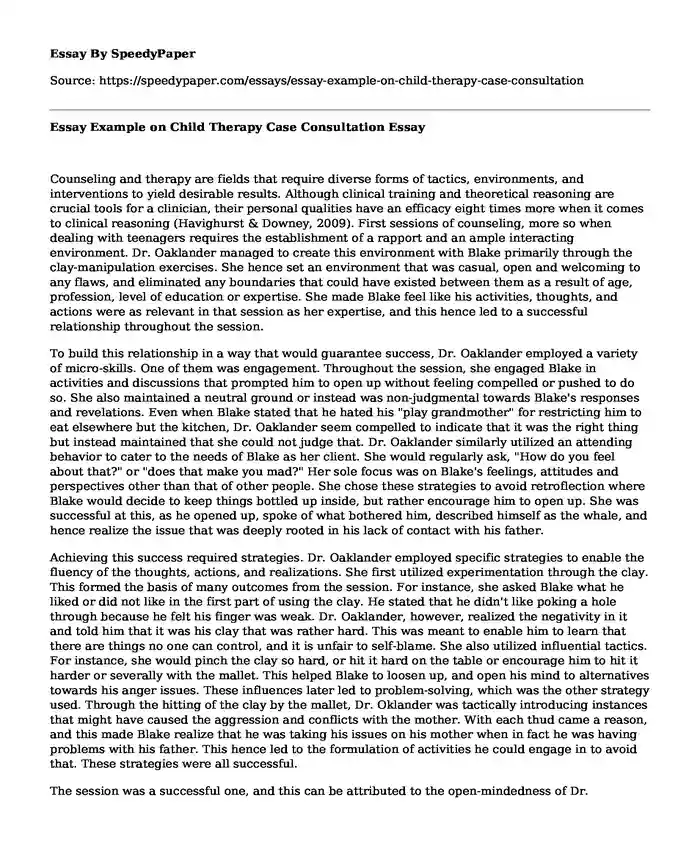
| Type of paper: | Essay |
| Categories: | Child development Counseling Behavior change |
| Pages: | 3 |
| Wordcount: | 810 words |
Counseling and therapy are fields that require diverse forms of tactics, environments, and interventions to yield desirable results. Although clinical training and theoretical reasoning are crucial tools for a clinician, their personal qualities have an efficacy eight times more when it comes to clinical reasoning (Havighurst & Downey, 2009). First sessions of counseling, more so when dealing with teenagers requires the establishment of a rapport and an ample interacting environment. Dr. Oaklander managed to create this environment with Blake primarily through the clay-manipulation exercises. She hence set an environment that was casual, open and welcoming to any flaws, and eliminated any boundaries that could have existed between them as a result of age, profession, level of education or expertise. She made Blake feel like his activities, thoughts, and actions were as relevant in that session as her expertise, and this hence led to a successful relationship throughout the session.
To build this relationship in a way that would guarantee success, Dr. Oaklander employed a variety of micro-skills. One of them was engagement. Throughout the session, she engaged Blake in activities and discussions that prompted him to open up without feeling compelled or pushed to do so. She also maintained a neutral ground or instead was non-judgmental towards Blake's responses and revelations. Even when Blake stated that he hated his "play grandmother" for restricting him to eat elsewhere but the kitchen, Dr. Oaklander seem compelled to indicate that it was the right thing but instead maintained that she could not judge that. Dr. Oaklander similarly utilized an attending behavior to cater to the needs of Blake as her client. She would regularly ask, "How do you feel about that?" or "does that make you mad?" Her sole focus was on Blake's feelings, attitudes and perspectives other than that of other people. She chose these strategies to avoid retroflection where Blake would decide to keep things bottled up inside, but rather encourage him to open up. She was successful at this, as he opened up, spoke of what bothered him, described himself as the whale, and hence realize the issue that was deeply rooted in his lack of contact with his father.
Achieving this success required strategies. Dr. Oaklander employed specific strategies to enable the fluency of the thoughts, actions, and realizations. She first utilized experimentation through the clay. This formed the basis of many outcomes from the session. For instance, she asked Blake what he liked or did not like in the first part of using the clay. He stated that he didn't like poking a hole through because he felt his finger was weak. Dr. Oaklander, however, realized the negativity in it and told him that it was his clay that was rather hard. This was meant to enable him to learn that there are things no one can control, and it is unfair to self-blame. She also utilized influential tactics. For instance, she would pinch the clay so hard, or hit it hard on the table or encourage him to hit it harder or severally with the mallet. This helped Blake to loosen up, and open his mind to alternatives towards his anger issues. These influences later led to problem-solving, which was the other strategy used. Through the hitting of the clay by the mallet, Dr. Oklander was tactically introducing instances that might have caused the aggression and conflicts with the mother. With each thud came a reason, and this made Blake realize that he was taking his issues on his mother when in fact he was having problems with his father. This hence led to the formulation of activities he could engage in to avoid that. These strategies were all successful.
The session was a successful one, and this can be attributed to the open-mindedness of Dr. Oklander. Bringing clay in a session that dealt with anger management could seem odd, but she used it to achieve the results she intended. There were a few hick-ups in the session when she interrupted Blake, and it looked like he did not have control of some parts of the session. She also unintentionally judged some instances but instantly confirmed that she did not mean to judge. From this session, I have learned that when it comes to dealing with a client, all predisposed information is inapplicable. It is always about building a relationship there and then. I have also come to note the efficacy and potency of props in the session room as it brings down the defense walls built up by clients, and encouraged them to open up and let everything out. At the end of a session, problem-solving is paramount.
References
Child therapy case consultation with violet Oaklander. Psychology.net. retrieved from https://moodle.esc.edu/mod/hsuforum/view.php?id=2230253
Havighurst S. S. & Downey L. (2009). Clinical Child Psychology and Psychiatry. 14(2). Pp. 251-271. DOI: 10.1177/1359104508100888 http://ccp.sagepub.com
Cite this page
Essay Example on Child Therapy Case Consultation. (2023, Jan 03). Retrieved from https://speedypaper.net/essays/essay-example-on-child-therapy-case-consultation
Request Removal
If you are the original author of this essay and no longer wish to have it published on the SpeedyPaper website, please click below to request its removal:
- Performance Management Essay Sample
- Free Essay: Theme of Power in Othello by William Shakespeare
- An Analysis of Formalism, Research Paper Sample
- What is Bitcoin? Get the Answer from This Essay Example
- Essay Example on Warehouse Management
- Essay Sample: Bank of America Versus Sundquist
- Essay Example on Historical Context of Ratification Debates
Popular categories




